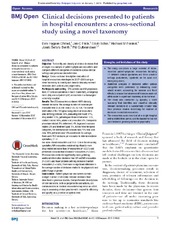| dc.contributor.author | Ofstad, Eirik Hugaas | en_US |
| dc.contributor.author | Frich, Jan C | en_US |
| dc.contributor.author | Schei, Edvin | en_US |
| dc.contributor.author | Frankel, Richard M. | en_US |
| dc.contributor.author | Benth, Jūratė Šaltytė | en_US |
| dc.contributor.author | Gulbrandsen, Pål | en_US |
| dc.date.accessioned | 2018-03-02T12:24:01Z | |
| dc.date.available | 2018-03-02T12:24:01Z | |
| dc.date.issued | 2018 | |
| dc.Published | Ofstad EH, Frich JC, Schei E, Frankel RM, Benth JŠ, Gulbrandsen P. Clinical decisions presented to patients in hospital encounters: a cross-sectional study using a novel taxonomy. BMJ Open. 2018;8:e018042 | eng |
| dc.identifier.issn | 2044-6055 | |
| dc.identifier.uri | https://hdl.handle.net/1956/17484 | |
| dc.description.abstract | Objective: To identify and classify all clinical decisions that emerged in a sample of patient–physician encounters and compare different categories of decisions across clinical settings and personal characteristics. Design: Cross-sectional descriptive evaluation of hospital encounters videotaped in 2007–2008 using a novel taxonomy to identify and classify clinically relevant decisions (both actions and judgements). Participants and setting: 372 patients and 58 physicians from 17 clinical specialties in ward round (WR), emergency room (ER) and outpatient (OP) encounters in a Norwegian university hospital. Results: The 372 encounters contained 4976 clinically relevant decisions. The average number of decisions per encounter was 13.4 (min–max 2–40, SD 6.8). The overall distribution of the 10 topical categories in all encounters was: defining problem: 30%, evaluating test result: 17%, drug related: 13%, gathering additional information: 10%, contact related: 10%, advice and precaution: 8%, therapeutic procedure related: 5%, deferment: 4%, legal and insurance related: 2% and treatment goal: 1%. Across three temporal categories, the distribution of decisions was 71% here-and-now, 16% preformed and 13% conditional. On average, there were 15.7 decisions per encounter in internal medicine specialties, 7.1 in ear–nose–throat encounters and 11.0–13.6 in the remaining specialties. WR encounters contained significantly more drug-related decisions than OP encounters (P=0.031) and preformed decisions than ER and OP encounters (P<0.001). ER encounters contained significantly more gathering additional information decisions than OP and WR encounters (P<0.001) and fewer problem defining decisions than WR encounters (P=0.028). There was no significant difference in the average number of decisions related to the physician’s and patient’s age or gender. Conclusions: Patient–physician encounters contain a larger number of clinically relevant decisions than described in previous studies. Comprehensive descriptions of how decisions, both as judgements and actions, are communicated in medical encounters may serve as a first step in assessing clinical practice with respect to efficiency and quality on a provider or system level. | en_US |
| dc.language.iso | eng | eng |
| dc.publisher | BMJ | eng |
| dc.relation.uri | http://bmjopen.bmj.com/content/8/1/e018042 | |
| dc.rights | Attribution CC BY-NC | eng |
| dc.rights.uri | http://creativecommons.org/licenses/by-nc/4.0/ | eng |
| dc.title | Clinical decisions presented to patients in hospital encounters: a cross-sectional study using a novel taxonomy | en_US |
| dc.type | Peer reviewed | |
| dc.type | Journal article | |
| dc.date.updated | 2018-01-08T05:53:46Z | |
| dc.description.version | publishedVersion | en_US |
| dc.rights.holder | Copyright 2018 The Author(s) | |
| dc.identifier.doi | https://doi.org/10.1136/bmjopen-2017-018042 | |
| dc.identifier.cristin | 1537259 | |
| dc.source.journal | BMJ Open | |

